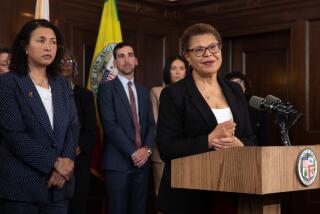Restore Fire Department funding, L.A. councilman urges
In reaction to ongoing controversy over emergency response times, a Los Angeles city councilman on Friday called for full funding to be restored to the Fire Department, whose budget has been slashed by more than 15% over the last three years.
The appeal from Councilman Paul Koretz came during a special council committee hearing in which Los Angeles Fire Chief Brian Cummings faced tough questions about how his department measures its responses to calls for help.
Koretz said he was dismayed by recent revelations that the department for years overstated how fast it was arriving on the scene of medical emergencies. Response times, he said, translate to survival rates. And the department’s latest statistics, which show it arriving at the scene of medical emergencies within five minutes only 60% of the time, means “we are not serving people in emergencies fast enough,” he said.
Two weeks ago, department officials admitted that they had been using a bad formula to calculate their response times. This week, amid criticism about other discrepancies in the department’s statistics, Cummings acknowledged that fire officials had presented the council and other city leaders with times that were projections based on computerized modeling, instead of actual performance numbers.
“This is not brain surgery,” Councilman Mitchell Englander said at Friday’s Public Safety Committee meeting, adding that he was “more frustrated than ever” to hear that the department had been using simulated data for response times from 2008 through 2010. “We already had the real data.”
Cummings defended the methodology, which he said enabled the department to compare different “what if” scenarios while making decisions about where to cut resources.
The chief told the panel that lawmakers were made aware last year that cutbacks would result in longer response times. “It was clearly stated ... there will be an impact on response times,” Cummings said. “Less is going to be less.”
But committee members said the department should have made it explicit that the figures presented in reports they considered while making the cuts were actually projections.
Councilman Paul Krekorian pointed to a 2011 report to Mayor Antonio Villaraigosa that presented the data as fact, instead of projection.
“Would we do things different now?” Cummings said in response. “Probably.”
It’s been a tough two weeks for Cummings, who has also faced questions about the department’s aging dispatch system. The Times has reported that equipment problems led to slow responses on several occasions around the city.
Cummings took heat on another front after he announced Tuesday that the department was halting its long-standing practice of releasing basic information about medical emergencies.
The mayor quickly ordered Cummings to immediately resume releasing the information, saying the department “needs more transparency — not less.”
Villaraigosa has also sought to quell concerns about the department’s transparency and performance. On Thursday, he called for the appointment of Jeff Godown, a former director of the Los Angeles Police Department’s crime-tracking Compstat Bureau, to oversee the Fire Department’s statistical analysis.
And he called for the activation of six additional ambulances, which would rotate for 10-hour shifts at fire stations around the city depending on the volume of emergency calls.
A budget analyst in the office of the chief administrative officer said it would cost more than $500,000 to staff the ambulances until the end of the fiscal year and said it was unclear how the new positions — and Godown’s salary — would be paid for.
It’s also unclear whether Koretz’s call to restore funding to the department is possible, given the city’s ongoing financial woes.
Englander said the City Council will not be able to make any budget decisions until it sees the results of the city controller’s pending audit of Fire Department response times. “That’s the most important thing right now,” he said. “What are the real numbers?”
More to Read
Start your day right
Sign up for Essential California for news, features and recommendations from the L.A. Times and beyond in your inbox six days a week.
You may occasionally receive promotional content from the Los Angeles Times.








